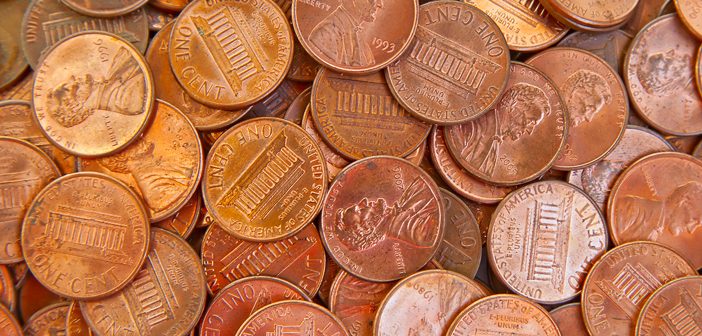For over two centuries, the penny has clinked in pockets, fallen between couch cushions, and served as a symbol of humble beginnings and lucky finds. But in today’s digital, fast-paced economy, the utility of the one-cent coin is fading — and so is its place in our currency. The end of the penny is on its way, here are a few things to consider as we prepare for this small coin’s big exit.
A costly coin.
One of the most compelling arguments for eliminating the penny is financial. The U.S. Mint has long spent more to produce a penny than its face value. In recent years, it has cost nearly 3.7 cents to mint and distribute a single penny — a loss of over two cents per coin. Multiply that by the hundreds of millions minted annually, and you’re looking at a significant, taxpayer-funded expense for an increasingly obsolete piece of currency. The government lost more than $85 million in 2024 by producing about 3 billion pennies. It’s estimated that ending the production of pennies will save approximately $56 million annually.
In addition, the penny contributes to inefficiency in daily transactions. Cashiers and customers alike spend extra time counting and handing out pennies — a small but compounding delay when scaled across millions of retail interactions every day.
Consumer and retailer adaptation.
Critics of the penny’s elimination often fear it could lead to price inflation or unfair rounding. However, evidence from other countries, such as Canada and New Zealand, which have successfully retired their smallest coins, shows that prices tend to be rounded in both directions, balancing out over time. Most cash transactions round to the nearest nickel, and electronic payments, including credit card purchases, remain unaffected.
Retailers are generally in favor of the idea. Many support rounding rules to streamline checkout processes, and some already offer “rounding policies” to make up for the lack of pennies when they run short.
A shift in spending habits.
Beyond cost and convenience, consumer behavior is another key factor. The rise of digital payment systems has drastically reduced the role of physical cash. Venmo, Apple Pay, credit cards, and contactless payments have made carrying coins nearly unnecessary. Millennials and Gen Z, in particular, are driving this shift toward a cashless economy.
The pandemic further accelerated this trend, pushing more businesses to adopt no-cash or exact-change-only policies due to coin shortages. In this environment, the penny’s role became not just minimal — but nearly irrelevant.
What to do with your pennies.
If the penny is on its way out, you may be wondering what to do with the jar (or bucket) full of coins collecting dust in your closet. Here are a few practical and even fun suggestions:
- Cash them in: Coin-counting machines (available in many grocery stores) allow you to convert your pennies into cash or gift cards. A word of caution, most of these coin-counting services charge a significant service fee, as much as 12%, plus a transaction fee. That’s a lot of pennies to pay for convenience.
Most banks and credit unions accept coins for deposit, but they are not required to by federal law — check with yours to see their policy. Our branches do accept pennies, but please roll them before bringing them to the branch nearest you. Unlike the coin-counting machines, there is no service charge.
- Open a savings account or certificate: A penny saved is a penny earned, and more, when you use your pennies to open our Online Savings account. You’ll earn 3.00% APR* with Direct Deposit (2.00% APY without Direct Deposit) – that’s more than 8x the national average.**
To earn even more, park those pennies into our Limited Time 4-Month Certificate. You’ll earn 4.00% APY†, a pretty penny on your pennies.
- Donate them: Many charities accept loose change, and some run specific penny drives. Your small coins can help fund big causes. Check out Charity Navigator to find a charity that matches your values.
- Get creative: Pennies can be used in DIY home décor — think mosaic tabletops, coasters, picture frames, or flooring. Some artists also use them for sculptural or craft projects.
- Teach kids about money: Pennies are a great way to teach children about saving, counting, and the basics of financial literacy. Our youth accounts are another way to help the young people in your life develop a saving habit.
- Hold onto the unique ones: Some older pennies, especially those minted before 1982 or with rare errors, might be worth more than face value. It’s worth doing a quick check before you dump them all in the coin machine or deposit them into your account.
Symbolism vs. pragmatism.
Some argue that eliminating the penny is unpatriotic. After all, it bears the likeness of Abraham Lincoln and has been an integral part of the U.S. identity for generations. However, this emotional connection must be weighed against practicality. The government can honor Lincoln’s legacy through other means, such as retaining him on the five-dollar bill or through educational initiatives.
Final thoughts.
The U.S. Treasury Department has placed its final order for penny blanks (metal disks used to “print” pennies), and production of pennies will end sometime in early 2026. If you still have pennies, you’ll still be able to use them in the future.
Whether you consider this small coin’s big exit a welcome change — or a change that doesn’t make “cents,” now’s the time to figure out what you’re going to do with your collection. No matter your plan, be sure to save a lucky one for National Lucky Penny Day, May 23, 2026.
*APY = Annual Percentage Yield. APY is the annualized rate based on a compounding period of one year. When the deposited money earns dividends and the accumulated dividends starts earning dividends as well, we are talking about compounding. Fees could reduce the earnings on an account. All yields except Certificate yields are subject to change retroactively to the beginning of the month.
Rate bonus is for a minimum of $1,000 monthly ACH Direct Deposit or Agent Net Check into a Farmers Insurance Federal Credit Union Checking Account. Rates are subject to change at any time.
No branch or call center access with this account.
**The national average for this type of account is 0.42% APY, based on rates published in the FDIC Monthly National Rates and Rate Caps accurate as of 01/21/2025.
†Limited Time Offer 4-Month Certificate / Rates are subject to change without notice. This is a promotional rate of 4.00% APY. Bonus Rate may not be combined with any other rate increase/bonus. Annual Percentage Yield (APY) is calculated on a 3.93% base rate, no minimum balance, regular share certificate requirement on a 365 day basis. IRA share certificates do not qualify for this promotion. Deposit must be new funds to the Credit Union and may not be transferred or withdrawn and deposited back into the Credit Union from any existing Credit Union account. No additional deposits accepted (other than dividends) during certificate term. There is a substantial penalty for early withdrawal of certificate funds. Fees and other conditions may reduce earnings. The 4-Month promotional certificate will automatically roll over to a regular 3-Month term certificate at maturity. Federal regulations require dividends be paid from available earnings; dividends are contingent upon this regulation. Refer to our TISA Disclosure for terms and conditions. APY = Annual Percentage Yield. This Promotional Rate is effective March 26, 2025 until further notice. Yields/rates are subject to change at any time. Fees could reduce the earnings on an account.





